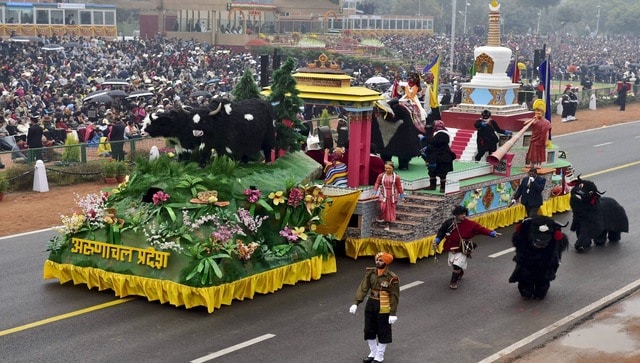A huge row has erupted over the selection of the colourful tableaux displayed during the Republic Day celebrations at Kartavya Path (formerly Rajpath) on 26 January. The Centre and several Opposition-ruled states are at odds over the rejection of their states’ tableaux.
The chief ministers of Karnataka and Punjab have attacked the Central government after their states’ tableaux were not selected for this year’s Republic Day parade. There will be no tableaux from Delhi and West Bengal as well this time.
Amid the spat, the Ministry of Defence (MoD) sources have defended the selection process, saying it was carried out in the “most transparent and consultative manner”, the news agency PTI reported.
What is the process for picking tableaux for the 26 January Republic Day parade? Why are states upset and what has the Central government said? Let’s take a closer look.
Process for tableaux selection
Every year, the Defence Ministry, which is responsible for the Republic Day celebrations, invites states, the Union Territories (UTs), Central government departments, and some constitutional authorities to send their tableau proposals.
As per an MoD circular issued last October, a select number of “State Governments/UT Administrations/Central/Ministries/Departments” each year send their tableaux to the R-Day parade.
Those interested in showcasing their tableaux submit a concept note and design blueprints to the MoD, reported Indian Express.
The overarching themes for this year’s tableaux are “Viksit Bharat” (Developed India) and “Bharat: Loktantra ki Matruka” (India: Mother of Democracy).
Who selects tableaux for the R-Day parade?
An expert committee, appointed by the Defence Ministry, comprising “distinguished persons” from the fields of arts, culture, painting, music, architecture, choreography, sculpture, etc., evaluate the tableaux proposals.
“The expert committee examines the proposals on the basis of theme, concept, design and its visual impact before making its recommendations,” The Quint reported citing the Defence Ministry.
The various stages of selection
In the first stage, this expert panel assesses the sketch/design of the proposals and suggests changes, if necessary, to representatives of the participants. Several proposals might be turned down in the initial stage only, reported Indian Express.
Once the sketches/designs are cleared by the committee, the participants are told to submit three-dimensional models of their proposals.
The panel examines these models in the second stage. If the model is approved, the tableau is sent for fabrication.
According to the MoD, “selection depends upon a combination of factors including but not limited to visual appeal, impact on the masses, idea/theme of the tableaux, degree of detailing involved in the tableaux, music accompanying the tableaux, local artists used etc.”
The selection process includes six to seven rounds of meetings spanning several days, with shortlisting and elimination at each stage, reported The Quint.
The expert committee has the final say in the selection process and can suggest modifications if required.
What can the tableaux include?
The Ministry of Defence elucidates the guidelines that state the do’s and dont’s for the tableaux.
The participants must engage “young qualified designers from renowned institutions” who would strictly supervise the proposed tableaux. The tableaux can also have electronic display walls for a bright display of images or content, moving elements using robotics or mechatronics, 3D printing for certain elements, utilisation of augmented or virtual reality, and special effects to improve the optics and visual effects, as per Indian Express.
The tableaux of two different states/ UTs must not be too alike. It should not have have writing or use of logos, except for the name of the state/ UT/department, which should be in Hindi on the front, English on the back, and in regional languages on the sides.
The MoD recommends using eco-friendly material for the construction of the tableaux.
The ministry also provides one tractor and one trailer for the tableau to each state.
ALSO READ: France’s Macron invited for Republic Day: How India selects its chief guest
Why are states upset?
Like every year, states are unhappy over the non-inclusion of their tableaux.
Karnataka chief minister Siddaramaiah has hit out at the Centre over the rejection of the state’s tableau, saying the government has “insulted seven crore Kannadigas”.
“The Central Government has insulted the seven crore Kannadigas by denying the opportunity for the state’s tableau at the Republic Day parade to be held in New Delhi on 26 January. Karnataka faced a similar situation even last year as our state’s tableau was initially rejected. They later permitted keeping Karnataka elections in mind. This time, the central government has again continued its trend of insulting Kannadigas,” he said in a post on social media.
Karnataka submitted seven tableau designs but all were rejected. These proposals included depicting the cultural ethos of the state, Brand Bengaluru, all GI-tagged products of the state, and so on. “A proposal showcasing the Congress’ five guarantees, Bengaluru’s growth spurt was also sent. That too got rejected,” a source in the Chief Minister’s Office told News18.
Punjab CM Bhagwant Mann also lashed out at the Centre, saying the government discriminated against the states ruled by the Aam Aadmi Party (AAP). Delhi’s tableau has also been rejected for this year’s parade. The UT had given four sketches, including one showing the Arvind Kejriwal-led government’s ‘mohalla’ clinics and education services, News18 reported.
Punjab had submitted three proposals, including themes like “Punjab’s history of sacrifices, women empowerment with Mai Bhago’s story, and the state’s rich cultural heritage”, as per Indian Express.
West Bengal’s tableau has also not been selected. The state submitted two designs, including the Kanyashree scheme and Kanyashree University, and the other on Bengal’s famous traditional dances and culture, reported News18.
What is the Centre saying?
Speaking to PTI, MoD sources said the tableaux from Delhi, Punjab and West Bengal were turned down as they didn’t align with the “broader theme” of this year’s Republic Day parade.
The sources said that the states and UTs that were not selected for the Republic Day parade have been invited to showcase their tableaux in Bharat Parv at Delhi’s Red Fort, from 23-31 January.
After four rounds of meetings, 16 States and UTs have been selected for the display of their tableaux for the 2024 Republic Day parade. These include Andhra Pradesh, Arunachal Pradesh, Chhattisgarh, Gujarat, Haryana, Jharkhand, Ladakh, Madhya Pradesh, Maharashtra, Manipur, Meghalaya, Odisha, Rajasthan, Tamil Nadu, Telangana and Uttar Pradesh, PTI reported.
A source told The Hindu that the expert committee constituting artists and Padma awardees, based on recommendations of the Indira Gandhi National Centre for the Arts and the Indian Council of Cultural Research, was formed this year. “The committee finalises the theme and aesthetics. The government, Minister or Secretary are not in the picture of the process,” the source added.
Meanwhile, the defence ministry has proposed a rollover plan for the states and UTs to showcase their tableaux in the next three Republic Day celebrations at Kartavya Path.
“Approximately 15 tableaux from the States and Union Territories are selected for the Republic Day parade every year. So everyone cannot be accommodated each year. Under the agreement, every State and UT will get an opportunity within three years. This is to ensure equitable distribution,” an official source told The Hindu.
The three-year memorandum of understanding (MoU) has been signed by 28 states so far, including Karnataka.
With inputs from agencies
Link to article –
Big row over Republic Day tableaux: How are they chosen for 26 January parade?





